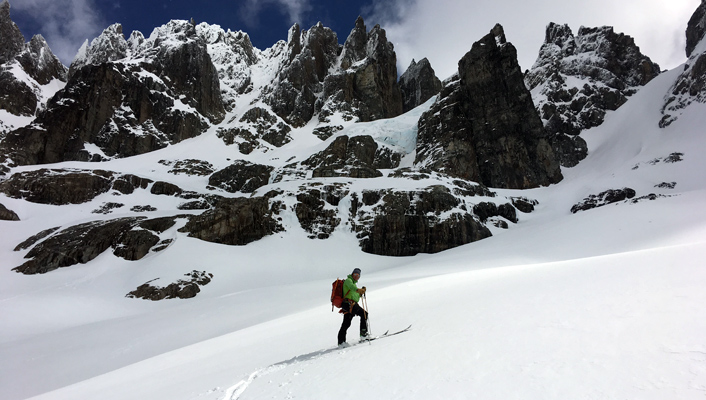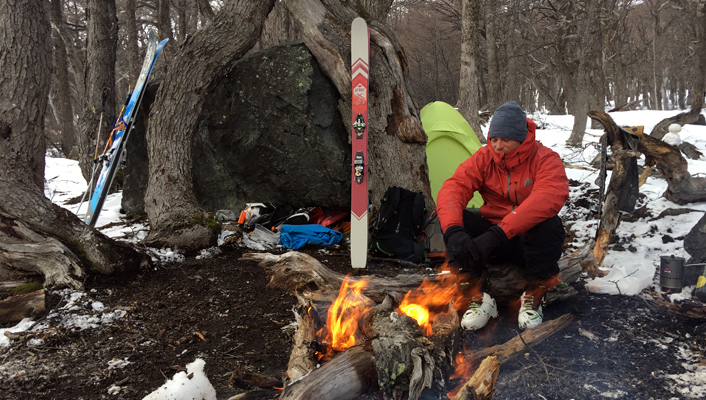I first met Jorge Kozulj in the lobby of a small hotel in Ushuaia, Argentina in 2009. We were gathered for an introductory guide meeting with Ice Axe Expeditions, discussing logistics for our ski cruise to Antarctica.
Kozulj was relaxed and friendly, humble and unassuming. A gregarious guide based out of Bariloche, Argentina, he quickly became a team favorite, endearing himself to our shipmates with humor during our 48-hour crossing of the infamous Drake Passage. Even while seasick and green in the face, he’d surface in the dining room for a cracker, nibbling ginger as he swayed with a big smile.

Jorge Kozulj flashes a grin on his sixth visit to Antarctica. [Photo] Courtesy Jorge Kozulj
But in 2005, when Argentina joined the International Federation of Mountain Guides Associations, Kozulj became one of 12 guides to gain full IFMGA certification in the country, although he’d already been guiding for several years by then.
Kozulj, 42, got his start in 1998 as a hiking/glacier guide, traveling between the regions of Bariloche, Calafate and El Chaltén. In 2001, he joined Cerro Catedral’s ski patrol, but while he reflects positively on the experience, he admits to feeling hemmed in by the inbounds regulations.
“I felt stuck in the patrol cabins, knowing and watching all the good lines that I could see to the west,” Kozulj says. “I felt trapped and bossed around. After a turning point at work, I decided to follow my heart and start guiding.” He put flyers all over Bariloche and, in his first five days of guiding, made the same income as he did in a month at Cerro Catedral.

Kozulj guiding in the remote Cerro Castillo area of Argentine Patagonia. [Photo] Courtesy Jorge Kozulj
“To be a mountain guide in Patagonia is challenging,” Kozulj explains. “Bariloche has a population of 150,000 and only 1,000 to 2,000 people go to the mountains. So, first, there’s not much of a mountain culture; second, it’s difficult to make a living; and third, it is hard work.” He estimates there are just 15 internationally certified guides working in Argentina and says he consistently interacts with about half of them, exchanging work opportunities and developing a close professional community.
His community extends beyond Argentina, too— Kozulj notes that he’s gained much from working with colleagues overseas, spending his springs in Norway, summers in Chamonix, France, and autumns in Antarctica before returning to Patagonia in July.
“At the beginning, it was very intimidating since I didn’t know what to expect with foreign guides,” he says. “Then, when we started working together…it gave me a lot more confidence when I could guide alongside with guys like Per [Ås] and Kris [Erickson], and I felt like ‘great minds thinks alike.’”

Amid marginal conditions, Kozulj dreams of things looking up. [Photo] Courtesy Jorge Kozulj
“Things are booming,” Kozulj says, “and this will bring chaos on one [hand] and work and education on the other. People are moving more into the backcountry, watching and learning. We need to be ready to manage this.”
He sees opportunities for formalized avalanche and mountain-skills education, as well as in the creation of lodges and comfortable hut systems like those of Europe, to encourage the exploration of new places. But, he says, tensions exist with the ski areas and in the government’s support for guides.
“The local ski areas do not recognize the importance of mountain guides,” he mentions. “There are no laws in place to protect us. New rules need to be created, and our guide community has the opportunity to help develop the ‘law’ for this.”
These days, Kozulj prefers slow growth for his company, which allows him to focus on his business’s soul rather than being encumbered by logistics. With a client base comprised mostly of North Americans, Europeans and a handful of Argentineans, he gains most of his customers via word of mouth from colleagues and former clients—and through the incomparable form of Argentinean cheerfulness I experienced on the Drake Passage in 2009.
“The Argentinian happiness is unbeatable,” he says. “We are a mix of Italian and Spaniards as a main dish. Then, add some salt and pepper with Eastern Europeans and [the] local people born here. We are fun, fast moving and sociable. We like to be happy, and we want everyone else to be, too.”










Same in chile man…!! We live happy, and love to share experiences on the mountains with friends…!!!
Yay, George!!!!!
Jorge is the BEST! Our family has been privileged to have him as our guide on two different trips to Argentina.